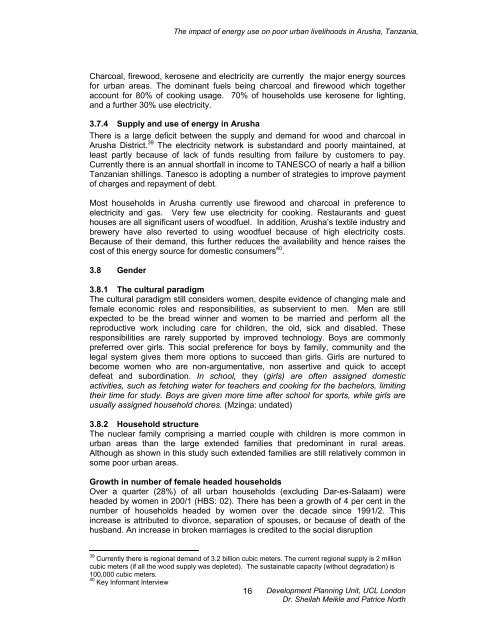The Impact of Energy Use on Poor Urban Livelihoods in ... - DfID
The Impact of Energy Use on Poor Urban Livelihoods in ... - DfID
The Impact of Energy Use on Poor Urban Livelihoods in ... - DfID
Create successful ePaper yourself
Turn your PDF publications into a flip-book with our unique Google optimized e-Paper software.
<str<strong>on</strong>g>The</str<strong>on</strong>g> impact <str<strong>on</strong>g>of</str<strong>on</strong>g> energy use <strong>on</strong> poor urban livelihoods <strong>in</strong> Arusha, Tanzania,<br />
Charcoal, firewood, kerosene and electricity are currently the major energy sources<br />
for urban areas. <str<strong>on</strong>g>The</str<strong>on</strong>g> dom<strong>in</strong>ant fuels be<strong>in</strong>g charcoal and firewood which together<br />
account for 80% <str<strong>on</strong>g>of</str<strong>on</strong>g> cook<strong>in</strong>g usage. 70% <str<strong>on</strong>g>of</str<strong>on</strong>g> households use kerosene for light<strong>in</strong>g,<br />
and a further 30% use electricity.<br />
3.7.4 Supply and use <str<strong>on</strong>g>of</str<strong>on</strong>g> energy <strong>in</strong> Arusha<br />
<str<strong>on</strong>g>The</str<strong>on</strong>g>re is a large deficit between the supply and demand for wood and charcoal <strong>in</strong><br />
Arusha District. 39 <str<strong>on</strong>g>The</str<strong>on</strong>g> electricity network is substandard and poorly ma<strong>in</strong>ta<strong>in</strong>ed, at<br />
least partly because <str<strong>on</strong>g>of</str<strong>on</strong>g> lack <str<strong>on</strong>g>of</str<strong>on</strong>g> funds result<strong>in</strong>g from failure by customers to pay.<br />
Currently there is an annual shortfall <strong>in</strong> <strong>in</strong>come to TANESCO <str<strong>on</strong>g>of</str<strong>on</strong>g> nearly a half a billi<strong>on</strong><br />
Tanzanian shill<strong>in</strong>gs. Tanesco is adopt<strong>in</strong>g a number <str<strong>on</strong>g>of</str<strong>on</strong>g> strategies to improve payment<br />
<str<strong>on</strong>g>of</str<strong>on</strong>g> charges and repayment <str<strong>on</strong>g>of</str<strong>on</strong>g> debt.<br />
Most households <strong>in</strong> Arusha currently use firewood and charcoal <strong>in</strong> preference to<br />
electricity and gas. Very few use electricity for cook<strong>in</strong>g. Restaurants and guest<br />
houses are all significant users <str<strong>on</strong>g>of</str<strong>on</strong>g> woodfuel. In additi<strong>on</strong>, Arusha’s textile <strong>in</strong>dustry and<br />
brewery have also reverted to us<strong>in</strong>g woodfuel because <str<strong>on</strong>g>of</str<strong>on</strong>g> high electricity costs.<br />
Because <str<strong>on</strong>g>of</str<strong>on</strong>g> their demand, this further reduces the availability and hence raises the<br />
cost <str<strong>on</strong>g>of</str<strong>on</strong>g> this energy source for domestic c<strong>on</strong>sumers 40 .<br />
3.8 Gender<br />
3.8.1 <str<strong>on</strong>g>The</str<strong>on</strong>g> cultural paradigm<br />
<str<strong>on</strong>g>The</str<strong>on</strong>g> cultural paradigm still c<strong>on</strong>siders women, despite evidence <str<strong>on</strong>g>of</str<strong>on</strong>g> chang<strong>in</strong>g male and<br />
female ec<strong>on</strong>omic roles and resp<strong>on</strong>sibilities, as subservient to men. Men are still<br />
expected to be the bread w<strong>in</strong>ner and women to be married and perform all the<br />
reproductive work <strong>in</strong>clud<strong>in</strong>g care for children, the old, sick and disabled. <str<strong>on</strong>g>The</str<strong>on</strong>g>se<br />
resp<strong>on</strong>sibilities are rarely supported by improved technology. Boys are comm<strong>on</strong>ly<br />
preferred over girls. This social preference for boys by family, community and the<br />
legal system gives them more opti<strong>on</strong>s to succeed than girls. Girls are nurtured to<br />
become women who are n<strong>on</strong>-argumentative, n<strong>on</strong> assertive and quick to accept<br />
defeat and subord<strong>in</strong>ati<strong>on</strong>. In school, they (girls) are <str<strong>on</strong>g>of</str<strong>on</strong>g>ten assigned domestic<br />
activities, such as fetch<strong>in</strong>g water for teachers and cook<strong>in</strong>g for the bachelors, limit<strong>in</strong>g<br />
their time for study. Boys are given more time after school for sports, while girls are<br />
usually assigned household chores. (Mz<strong>in</strong>ga: undated)<br />
3.8.2 Household structure<br />
<str<strong>on</strong>g>The</str<strong>on</strong>g> nuclear family compris<strong>in</strong>g a married couple with children is more comm<strong>on</strong> <strong>in</strong><br />
urban areas than the large extended families that predom<strong>in</strong>ant <strong>in</strong> rural areas.<br />
Although as shown <strong>in</strong> this study such extended families are still relatively comm<strong>on</strong> <strong>in</strong><br />
some poor urban areas.<br />
Growth <strong>in</strong> number <str<strong>on</strong>g>of</str<strong>on</strong>g> female headed households<br />
Over a quarter (28%) <str<strong>on</strong>g>of</str<strong>on</strong>g> all urban households (exclud<strong>in</strong>g Dar-es-Salaam) were<br />
headed by women <strong>in</strong> 200/1 (HBS: 02). <str<strong>on</strong>g>The</str<strong>on</strong>g>re has been a growth <str<strong>on</strong>g>of</str<strong>on</strong>g> 4 per cent <strong>in</strong> the<br />
number <str<strong>on</strong>g>of</str<strong>on</strong>g> households headed by women over the decade s<strong>in</strong>ce 1991/2. This<br />
<strong>in</strong>crease is attributed to divorce, separati<strong>on</strong> <str<strong>on</strong>g>of</str<strong>on</strong>g> spouses, or because <str<strong>on</strong>g>of</str<strong>on</strong>g> death <str<strong>on</strong>g>of</str<strong>on</strong>g> the<br />
husband. An <strong>in</strong>crease <strong>in</strong> broken marriages is credited to the social disrupti<strong>on</strong><br />
39<br />
Currently there is regi<strong>on</strong>al demand <str<strong>on</strong>g>of</str<strong>on</strong>g> 3.2 billi<strong>on</strong> cubic meters. <str<strong>on</strong>g>The</str<strong>on</strong>g> current regi<strong>on</strong>al supply is 2 milli<strong>on</strong><br />
cubic meters (if all the wood supply was depleted). <str<strong>on</strong>g>The</str<strong>on</strong>g> susta<strong>in</strong>able capacity (without degradati<strong>on</strong>) is<br />
100,000 cubic meters.<br />
40<br />
Key Informant Interview<br />
16 Development Plann<strong>in</strong>g Unit, UCL L<strong>on</strong>d<strong>on</strong><br />
Dr. Sheilah Meikle and Patrice North
















